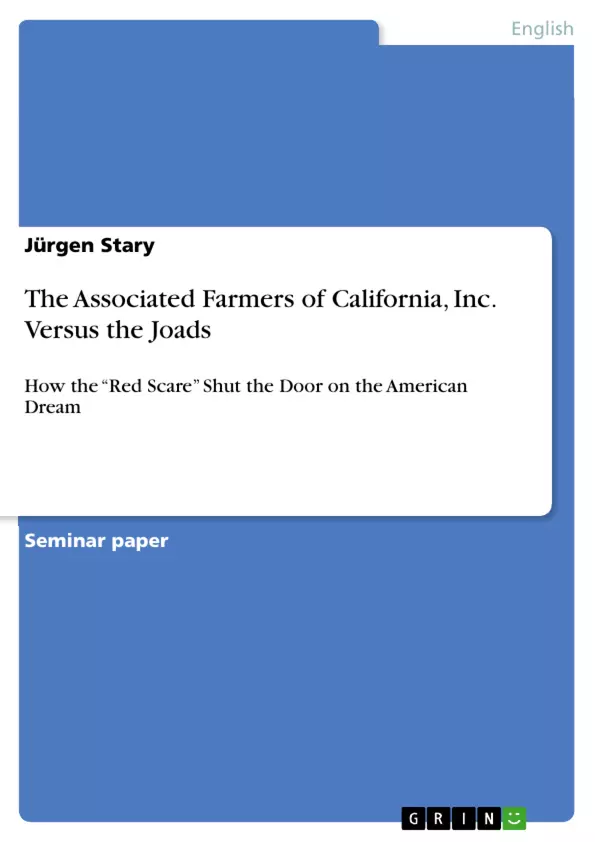This thesis paper analyzes how Steinbeck´s Joads in The Grapes of Wrath were discriminated and violated in their civil rights by fellow Americans under the banner of the “Red Scare”, effectively shutting the door on their personal American Dream for the time being, by stripping them off rights granted by the Founding Fathers to every American. This paper will look at facts why those tactics and methods have been - and to some part - are still successful within the American society in dividing it and creating fear, anger and social unrest within society.
Inhaltsverzeichnis (Table of Contents)
- Introduction
- Origin of the "Red Scare"
- The "Red Scare" and the American Dream
- The Grapes of Wrath in the Context of the "Red Scare"
- Style and Language
- The Suffering of the Joads Under the "Red Scare" Paranoia
- The Autocracy of the AF
- The Right to Life and Liberty
- The Right to Private Ownership of Property
- The Motivations and Methods Behind the “Red Scare” Tactics
- Motivation by Greed
- Motivation by Existential Fear
- Methods of Repression
Zielsetzung und Themenschwerpunkte (Objectives and Key Themes)
This thesis paper examines the portrayal of the "Red Scare" and its impact on the Joads, a migrant family in John Steinbeck's The Grapes of Wrath, and how it hindered their pursuit of the American Dream. The paper analyzes how the "Red Scare" functioned as a tool for discrimination and violation of civil rights, ultimately creating a system of oppression and fear.
- The "Red Scare" and its influence on the American Dream
- The portrayal of the Joads' struggles under the "Red Scare" paranoia
- The tactics and methods used by the Associated Farmers of California to repress migrant workers
- The role of greed and fear in driving the "Red Scare" movement
- The consequences of the "Red Scare" for social cohesion and the pursuit of individual liberty
Zusammenfassung der Kapitel (Chapter Summaries)
The introduction of the paper explores Steinbeck's The Grapes of Wrath as a critical social novel and the controversial reactions it received, highlighting the author's commitment to social justice. It sets the stage for the analysis of the "Red Scare" and its impact on the Joads' pursuit of the American Dream. The paper delves into the historical context of the "Red Scare" in America, tracing its roots back to the end of World War I and the subsequent economic crisis. It explores the economic and social anxieties that fueled the "Red Scare" and the tactics used to maintain social control and suppress dissent. The chapter focuses on the portrayal of the "Red Scare" in The Grapes of Wrath, analyzing how the Associated Farmers of California exploited the anxieties of the time to create a climate of fear and prejudice against migrant workers. This section examines the consequences of this fear-mongering for the Joads' quest for a better life and their struggle to achieve the American Dream.
Schlüsselwörter (Keywords)
This paper explores the themes of the "Red Scare," social justice, the American Dream, labor exploitation, fear-mongering, civil rights violations, and the relationship between social unrest and economic hardship in the context of John Steinbeck's The Grapes of Wrath. Key concepts include the role of the Associated Farmers of California in perpetuating the "Red Scare," the methods of repression used against migrant workers, and the impact of the "Red Scare" on the individual pursuit of happiness and economic security.
- Citar trabajo
- Jürgen Stary (Autor), 2012, The Associated Farmers of California, Inc. Versus the Joads, Múnich, GRIN Verlag, https://www.grin.com/document/200577



